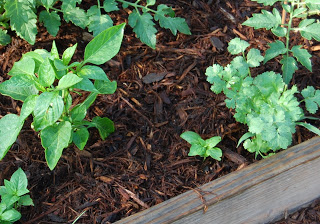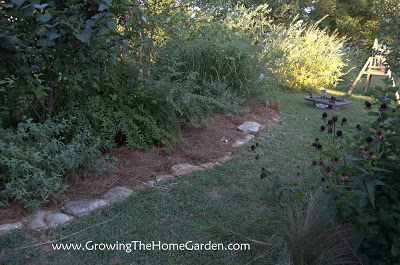Garden mulch can be an essential part of your garden. Mulch has a number of benefits including keeping the moisture in the soil and adds beneficial organic matter. Mulch can be valuable in reducing weed pressure as well. How much mulch do you need? Below is a simple mulch calculator to help you determine how much mulch you need for your garden beds. Underneath that I’ve put some more information on garden mulches that you may find useful!
Mulch Calculator
Input your garden dimensions to calculate how much mulch you will need.
How to Use the Mulch Calculator
Input the length and width of your garden bed. The default setting is to 2 inches but you can change this if you want deeper mulch. This calculator can also be used for other materials such as gravel, soil, or compost.
Types of Garden Mulches

- Wood chips: These are made from chipped or shredded bark or branches and are commonly used as garden mulch. Wood chip mulch is one of the most common types you will see. It can be both decorative and functional. Sometimes you can get woodchips for free from local tree cutters but be sure to give it time to cure. Fresh wood chips placed in a garden may leach nitrogen from the soil.
- Straw: This is a popular type of mulch that can be used to retain moisture and regulate soil temperature. Straw is often used in vegetable gardens.
- Leaves: Dried leaves can be used as mulch to suppress weed growth and add nutrients to the soil as they decompose. The awesome thing about leaves is that they are cheap – meaning usually free! The downside is they may contain tree seeds and you may find some tree germination in your garden beds.
- Grass clippings: Grass clippings can be used as mulch to add nutrients to the soil, but be sure to avoid using grass clippings from lawns that have been treated with herbicides. I also don’t recommend using grass from Bermuda or other creeping grasses. Those grasses have a tendency to root in garden beds.
- Compost: Compost can be used as a soil amendment and a mulch to improve soil quality and retain moisture. Compost makes the world go round! If there is one thing you do for your garden it should be to add compost!
- Pine needles: Pine needles are acidic and can be used to mulch acid-loving plants such as blueberries and rhododendrons.
- Shredded newspaper: This is a cost-effective and eco-friendly mulch option that can help suppress weeds and retain moisture in the soil. This is a less decorative mulch but can be used in a vegetable garden very effectively.
- Cocoa bean shells: These are a byproduct of chocolate production and can be used as a fragrant and attractive garden mulch.

Benefits of Garden Mulch
- Moisture retention: Mulch can help to retain soil moisture by reducing evaporation, which can be particularly beneficial during hot and dry weather.
- Weed suppression: Mulch can help to suppress weed growth by blocking light and preventing weed seeds from germinating.
- Soil temperature regulation: Mulch can help to regulate soil temperature by insulating the soil from extreme heat or cold.
- Soil nutrient retention: Mulch can help to prevent soil erosion and nutrient loss by keeping soil in place and adding organic matter to the soil as it decomposes.
- Soil structure improvement: As mulch breaks down, it can improve soil structure and texture by adding organic matter and improving soil aeration and drainage.
- Pest and disease control: Some types of mulch, such as cedar or cypress mulch, can help to repel certain pests and diseases.
- Aesthetics: Mulch can provide an attractive finishing touch to your garden by creating a uniform look and enhancing the color and texture of your plants.
How Deep Should Your Garden Mulch Be?
Generally your mulch should not exceed two inches in depth if planting around plants. Deeper than that could cause negative effects to the surrounding plantings. If your goal is to smother an area then deeper is fine. For example you may wish to dump a large load of mulch over a future garden area and you are using the mulch mostly to smother weed growth in that spot. In that case try for 6 to 8 inches of mulch. Adding a layer of carboard underneath would help with weed suppression as well.
Should You Use Weed Fabric Under Mulch?
I generally recommend to NOT use weed fabric. Often weeds will land on top of the mulch then their roots penetrate and grab on to the weed fabric. This can actually make weeds more difficult to remove once the roots have gotten a hold of the weed fabric. These weeds will lead to cuts or tears in the fabric reducing it’s usefulness.

Are Stones Good to Use as Mulch?
In some areas stone may be a good mulch option. They don’t break down over time, they will shade the soil underneath which will keep the soil cooler, and they can look pretty neat. However I’m not a fan of stone mulch in our area. Weed seeds will land on top of mulches of all kinds and can eventually germinate in your garden beds even with stone. Stone mulches are more work to weed around. Additionally I like the fact that organic mulches break down over time because they feed the soil underneath which helps with your soil fertility.
More Information from Growing The Home Garden
What to Do in Your Garden in Late August | Late Summer Gardening Tips
Late August is an important time in the garden. The summer heat is still with us, but cooler weather is on the way. For gardeners in zone 7, this is the point where preparation meets transition—wrapping up the summer season while setting the stage for fall and even next spring. If you’re in a warmer zone, you may have more…
Viburnum nudum: A Native Alternative to Invasive Shrubs
If you’re looking for a versatile, wildlife-friendly shrub with four-season appeal, Viburnum nudum absolutely deserves a spot in your garden. Commonly called possumhaw viburnum, raisin tree, or witherod viburnum, this native plant brings glossy green leaves, colorful fall foliage, and clusters of berries that both birds and pollinators love. Best of all, viburnums are great a native replacement for many…
How to Prune and Deadhead Echinacea (Coneflower) to Prevent Aster Yellows
Coneflowers (Echinacea), with their vibrant blooms and pollinator appeal, are a staple in many home gardens. In this post, I’ll share my approach to pruning coneflowers to encourage healthy blooms, support pollinators, and provide food for birds later in the season. I’ll also cover a serious plant disease—aster yellows—that can affect coneflowers and other members of the aster family, and…
How to Propagate a Dogwood Tree from Cuttings (Cornus florida)
I successfully rooted a Florida dogwood (Cornus florida) from a cutting! This is a tree that’s been tricky in the past for me to propagate, and I finally had some success I think is worth sharing. In this post, I’ll walk you through exactly what worked, step-by-step instructions for how to root flowering dogwood cuttings yourself, and some tips and…
Discover more from Growing The Home Garden
Subscribe to get the latest posts sent to your email.





